Strategies for Running Effective Project Meetings

Introduction
In today's fast-paced business environment, running effective project meetings is crucial for ensuring project success and maintaining team morale. With so many moving parts and stakeholders involved, project managers must navigate through various challenges to keep their teams focused, engaged, and productive. This article provides an in-depth exploration of key strategies and best practices for running effective project meetings, ensuring your projects remain on track and your teams stay motivated.
Throughout this article, we will delve into the following strategies:
- Determine Meeting Frequency and Duration
- Define Meeting Goals and Objectives
- Develop a Meeting Agenda
- Encourage Participation and Collaboration
- Manage Meeting Dynamics
- Follow Up on Action Items
- Evaluate Meeting Effectiveness
By understanding and implementing these strategies, project managers can maximize the value of their meetings, strengthen team collaboration, and ultimately, drive project success.
Determine Meeting Frequency and Duration
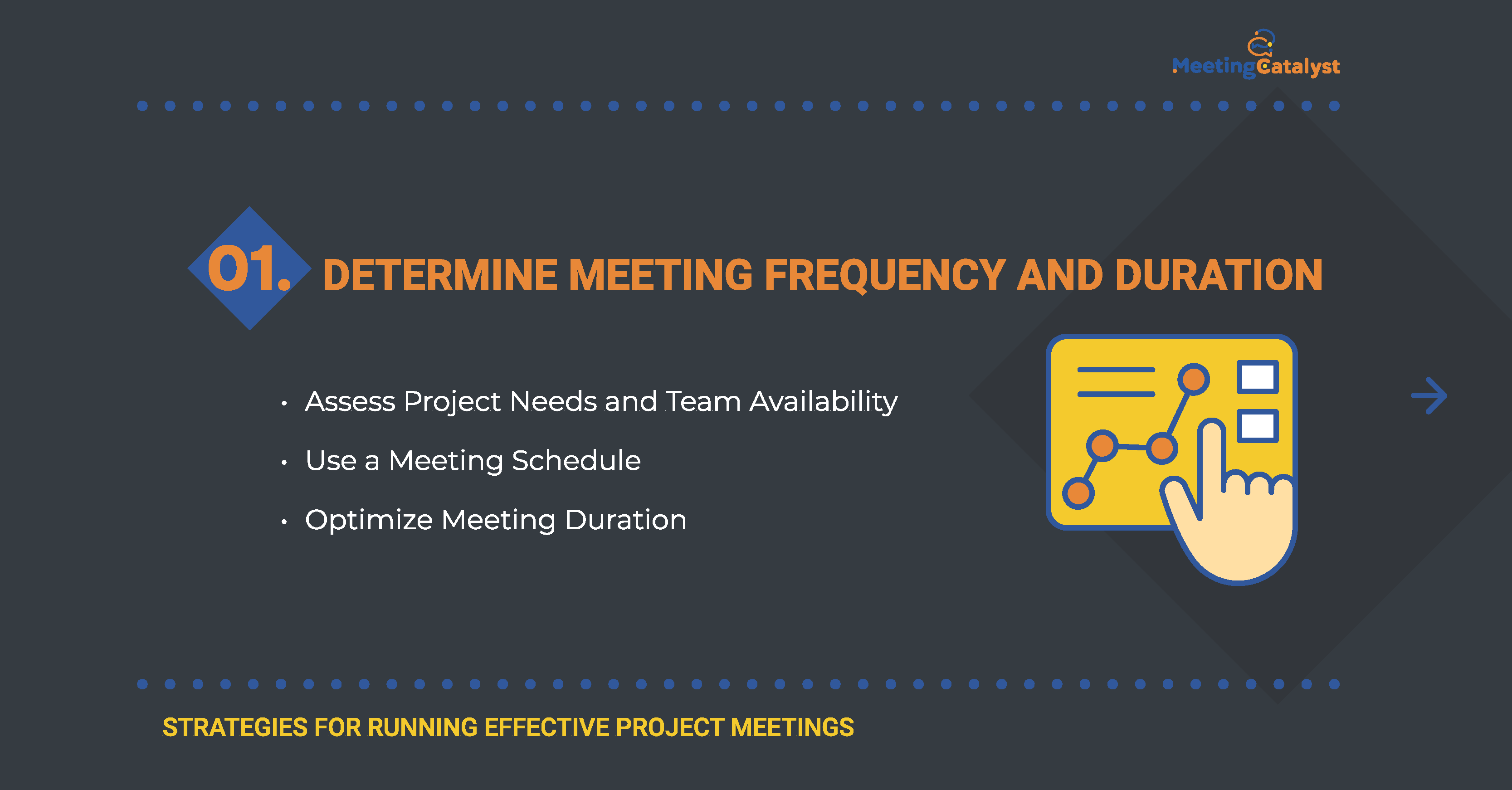
Striking the right balance in meeting frequency and duration is essential to maintain productivity and avoid overwhelming your team with excessive meetings. Careful planning and consideration will help you ensure that meetings are held as needed, without wasting valuable time or resources.
Assess Project Needs and Team Availability
Begin by assessing the unique needs of your project and the availability of your team members. Consider factors such as project complexity, deadlines, and team members' work schedules when determining the appropriate meeting frequency and duration.
Keep in mind that different phases of the project may require different meeting schedules. For instance, during the initial planning stage, you may need more frequent meetings to establish goals and objectives, while the execution phase may require fewer but more focused meetings.
Be flexible and willing to adjust the meeting schedule as needed based on project progress, team feedback, and unforeseen changes.
Use a Meeting Schedule
Develop a meeting schedule that outlines the planned frequency and duration of meetings for the entire project or specific project phases. This schedule will help ensure that meetings are held consistently and will allow team members to plan their workloads accordingly.
Clearly communicate the meeting schedule to all team members and stakeholders, ensuring everyone is aware of upcoming meetings and any changes to the schedule.
Optimize Meeting Duration
Be mindful of the time you allocate for each meeting. Too long, and you risk losing participants' focus; too short, and you may not have enough time to cover all necessary topics. Aim for a duration that allows for thorough discussion without causing fatigue or disengagement.
Keep meetings focused and on track by setting time limits for each agenda item, and consider using a timer or appointing a timekeeper to monitor the progress of the meeting.
By effectively determining the frequency and duration of your project meetings, you'll create an environment that promotes productivity, collaboration, and ultimately, project success. Consider the example of a project manager who implemented a flexible meeting schedule that adapted to the project's evolving needs, resulting in increased team engagement and more efficient use of everyone's time.
Define Meeting Goals and Objectives
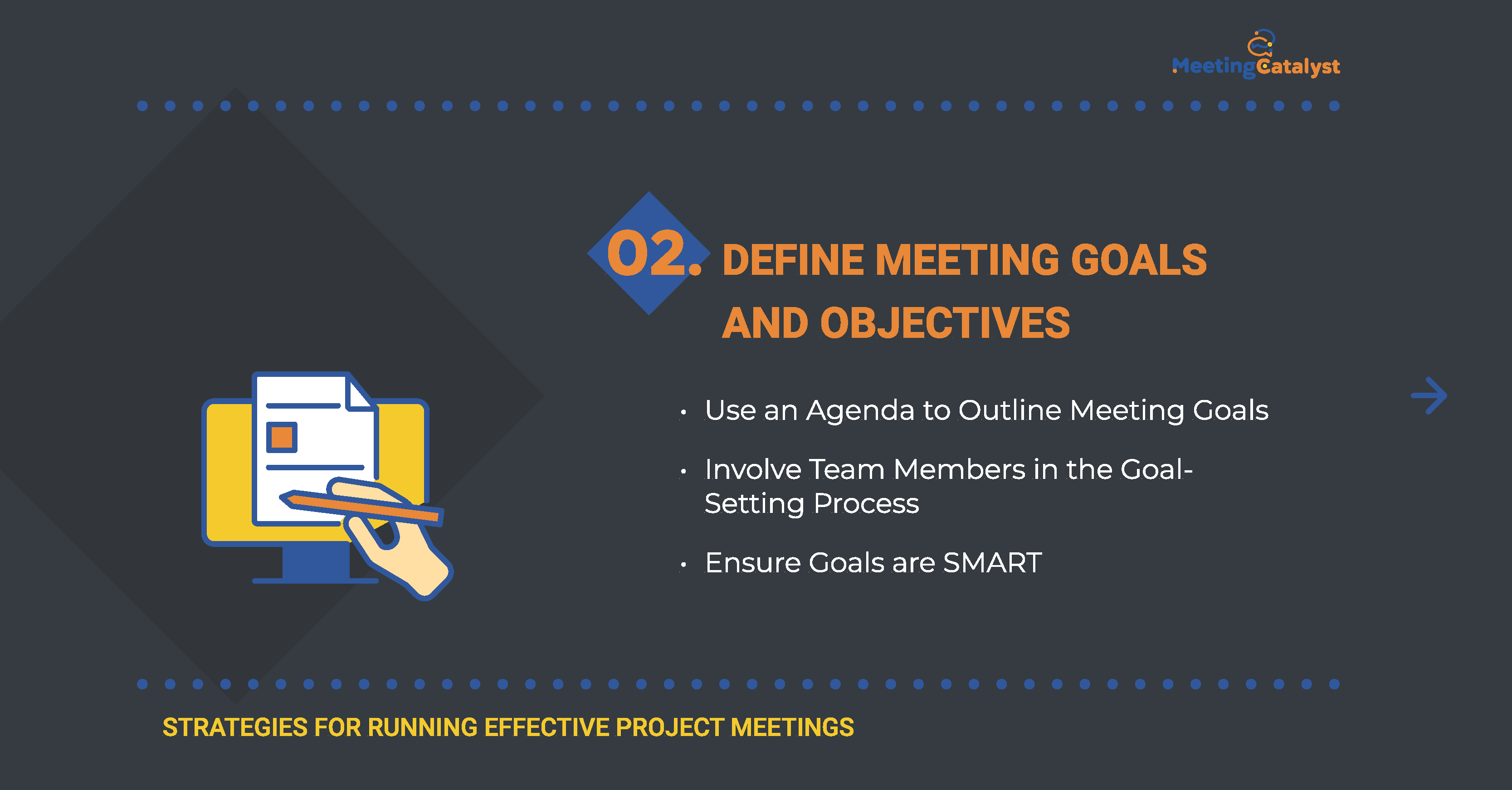
Clearly defining meeting goals and objectives is crucial for maintaining focus and ensuring the productivity of your project meetings. Establishing specific goals helps prevent meetings from devolving into unproductive discussions or unrelated tangents, ultimately contributing to the overall success of your project.
Use an Agenda to Outline Meeting Goals
Develop a structured agenda for each meeting that includes specific goals and objectives. This will provide a clear roadmap for the discussion and help participants understand what needs to be accomplished during the meeting.
Share the agenda with all meeting participants ahead of time, allowing them to review the goals and objectives and come prepared with any relevant information, questions, or suggestions.
Involve Team Members in the Goal-Setting Process
Encourage team members to contribute to the goal-setting process by soliciting their input on what they believe should be covered in the meeting. This can help ensure that all necessary topics are addressed and foster a sense of ownership and engagement among team members.
Regularly review and update meeting goals and objectives based on team feedback, project progress, and any changes in project requirements or priorities.
Ensure Goals are SMART
- Ensure that your meeting goals and objectives are SMART (Specific, Measurable, Achievable, Relevant, and Time-bound). This will help maintain focus during the meeting and enable you to better evaluate the success of the meeting afterward.
For example, a project manager who prioritized defining clear meeting goals and objectives experienced improved meeting efficiency and team engagement. By involving team members in the goal-setting process and ensuring that goals were SMART, the project manager facilitated more productive discussions and achieved better project outcomes.
Develop a Meeting Agenda
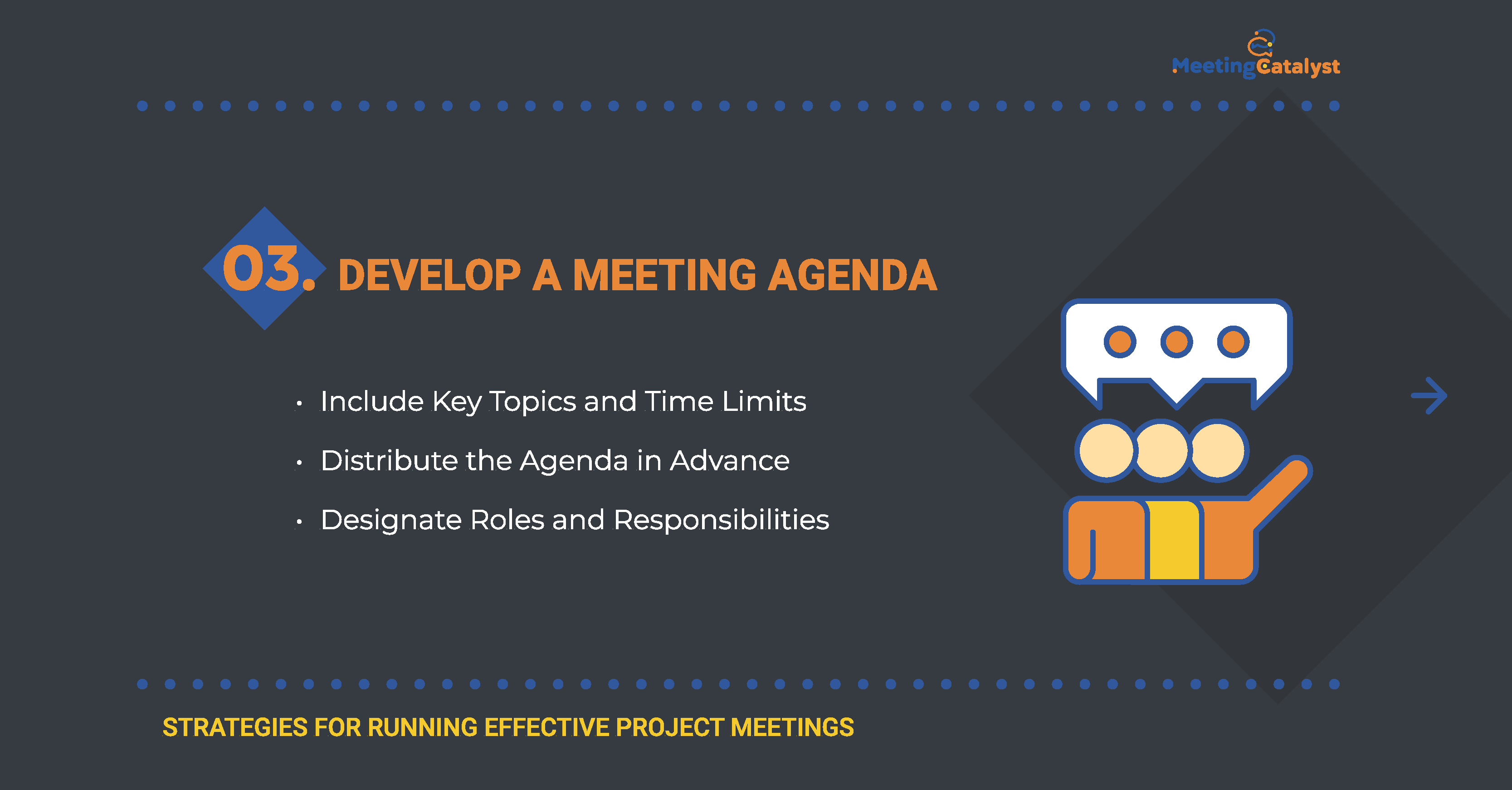
A well-structured meeting agenda is essential for keeping meetings on track and focused. By providing a clear outline of key topics and time allocations, an agenda ensures that participants come prepared and engaged, ultimately leading to more productive project meetings.
Include Key Topics and Time Limits
Begin by listing the key topics to be covered in the meeting, based on the goals and objectives you have already defined. Be sure to prioritize the most important items to be addressed.
Assign a specific time limit to each topic, ensuring that the meeting does not run over the allotted time. This will encourage participants to stay focused and help prevent discussions from meandering off course.
Allocate additional time for any unplanned discussions or issues that may arise during the meeting, allowing for flexibility without compromising the overall meeting duration.
Distribute the Agenda in Advance
Share the meeting agenda with all participants well in advance of the meeting, giving them ample time to review the topics, prepare any necessary materials, and formulate questions or ideas.
Encourage participants to provide feedback on the agenda, and make any necessary adjustments based on their input. This will help ensure that all relevant topics are addressed and that everyone feels engaged in the process.
Designate Roles and Responsibilities
Assign specific roles and responsibilities to team members for each agenda item, such as leading discussions, presenting updates, or taking meeting notes. This will help keep the meeting running smoothly and ensure that everyone is actively involved in the process.
Clearly communicate these roles and responsibilities to the team members before the meeting, allowing them to prepare adequately and contribute effectively.
A project manager who implemented a well-structured meeting agenda saw a significant improvement in meeting productivity and team engagement. By including key topics, assigning time limits, and distributing the agenda in advance, the project manager fostered focused discussions and ensured that all critical issues were addressed. This effective use of meeting agendas contributed to the overall success of the project.
Encourage Participation and Collaboration
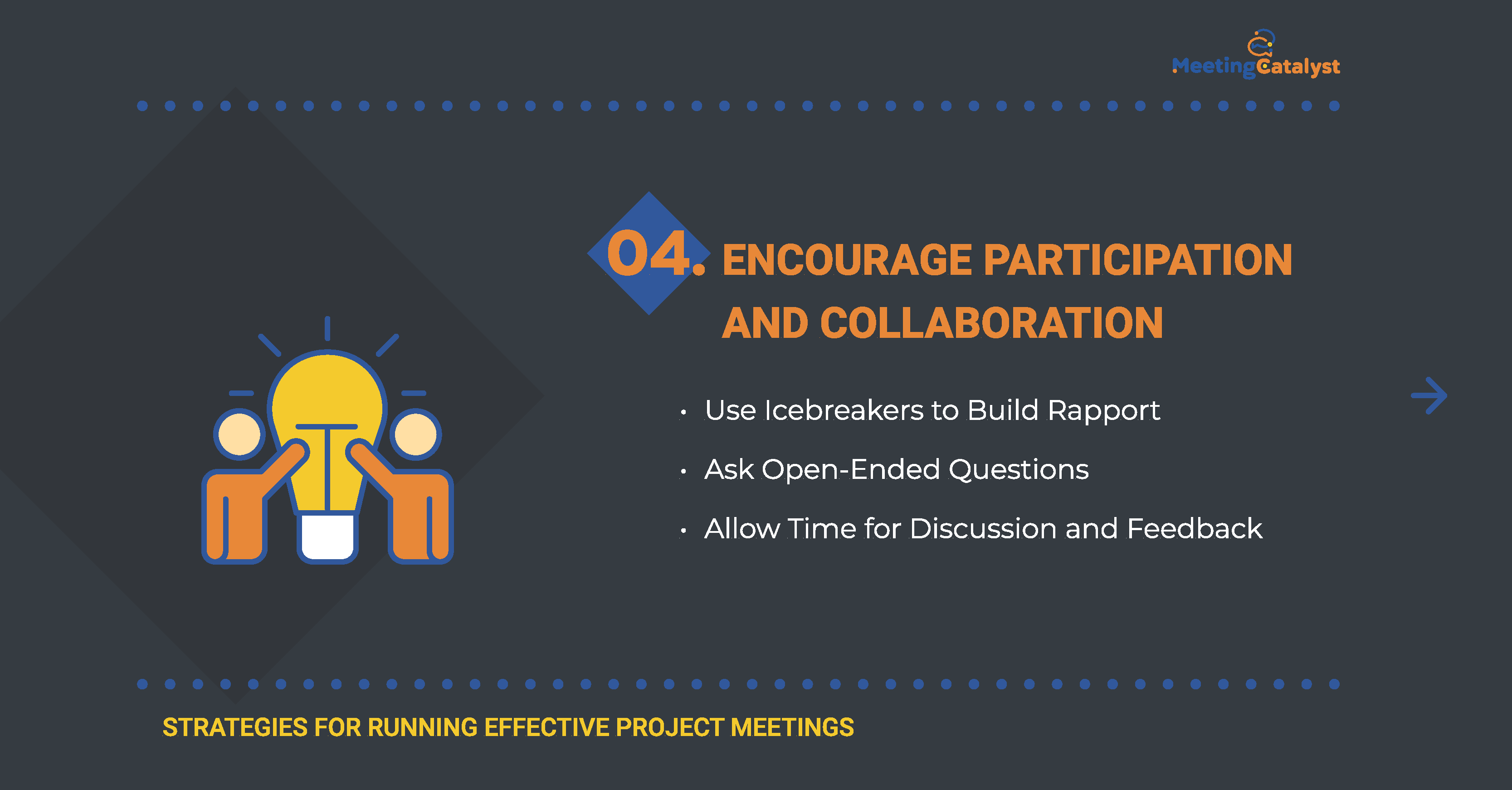
Fostering an environment where all team members feel valued and engaged is crucial for effective project meetings. By encouraging participation and collaboration, you can tap into the collective knowledge and expertise of your team, leading to more informed decisions and better project outcomes.
Use Icebreakers to Build Rapport
Start meetings with icebreakers or team-building activities to help participants feel more at ease and connected with one another. This can improve the overall meeting atmosphere and encourage open communication.
Keep icebreakers short and relevant to the project or team, and ensure they are inclusive for all team members.
Ask Open-Ended Questions
Use open-ended questions to stimulate discussion and elicit input from all team members. By asking questions that require more than a simple "yes" or "no" answer, you encourage participants to think critically and share their perspectives.
Be sure to direct questions to specific individuals when appropriate, particularly if they have expertise or insights relevant to the topic at hand.
Allow Time for Discussion and Feedback
Allocate time in the agenda specifically for discussion and feedback, ensuring that all team members have the opportunity to voice their opinions and ideas.
Encourage active listening and respectful debate, fostering an environment where diverse perspectives are valued and considered.
Acknowledge and address any concerns or issues raised by team members, demonstrating your commitment to collaborative problem-solving and ongoing improvement.
One project manager successfully increased participation and collaboration by implementing these strategies in their project meetings. By using icebreakers, asking open-ended questions, and allowing time for discussion and feedback, the project manager created an inclusive and engaging meeting environment. As a result, team members felt more comfortable sharing their ideas and expertise, ultimately leading to more informed decisions and better project outcomes.
Manage Meeting Dynamics
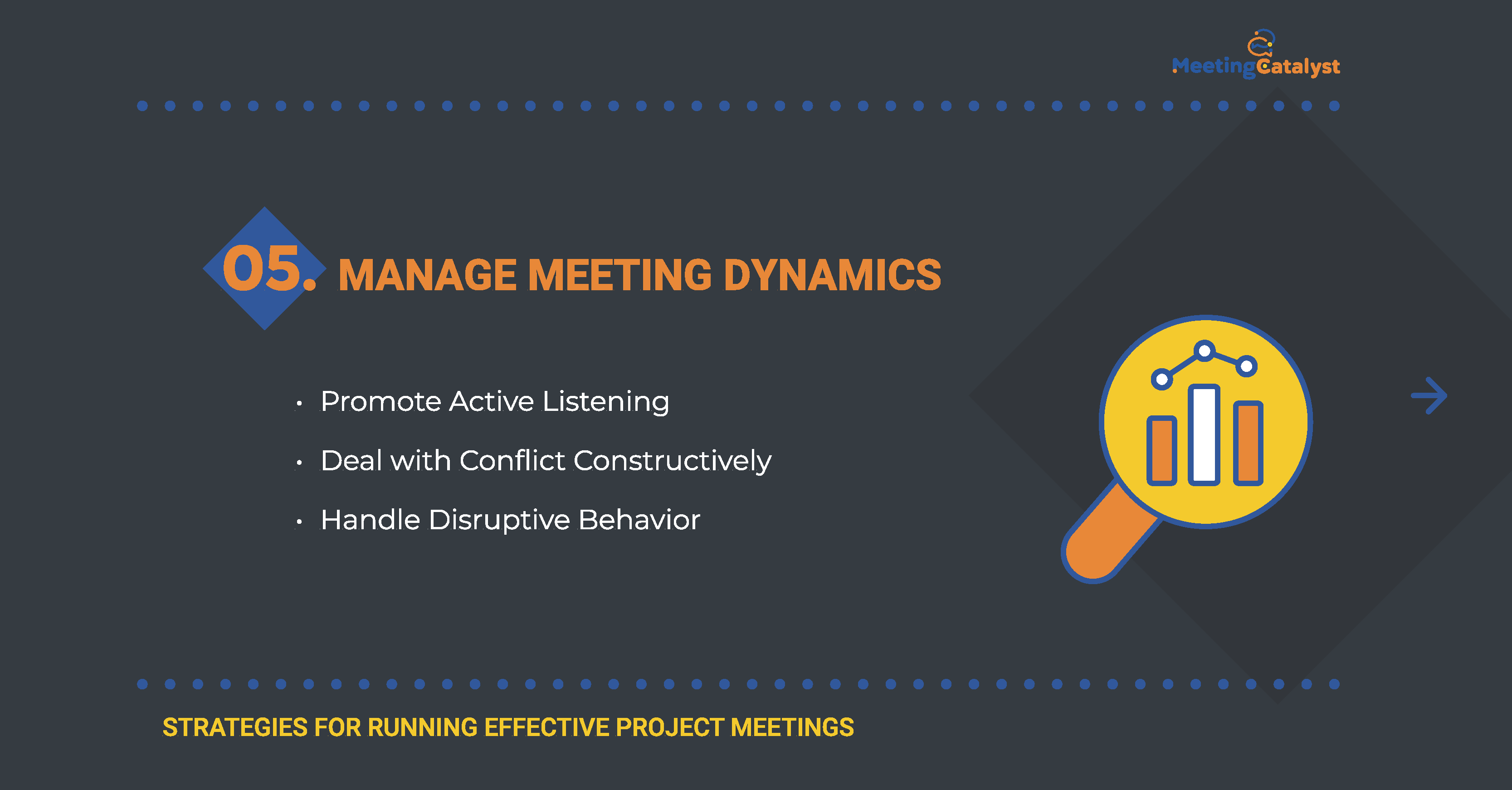
Managing meeting dynamics is a critical aspect of running effective project meetings. By fostering collaboration, communication, and engagement, you can create an environment where all team members can contribute and work together effectively.
Promote Active Listening
Encourage team members to practice active listening by giving their full attention to the speaker and making an effort to understand their perspective. This can lead to more productive discussions and greater respect among team members.
Reinforce the importance of active listening by modeling it yourself and acknowledging the contributions of others.
Deal with Conflict Constructively
Address conflicts that arise during meetings in a constructive and timely manner. Ignoring or avoiding conflict can lead to unresolved issues and negatively impact team dynamics.
Focus on the issue at hand rather than personal differences, and seek to find common ground and mutually beneficial solutions.
Be open to feedback and willing to adjust your approach when necessary, demonstrating your commitment to the team's success.
Handle Disruptive Behavior
Address disruptive behavior, such as excessive interruptions or dominating the conversation, in a tactful and respectful manner. Establishing ground rules for meeting conduct can help prevent such behavior and ensure a productive meeting environment.
If needed, have a private conversation with the individual causing the disruption to discuss their behavior and its impact on the team.
One project manager effectively managed meeting dynamics by implementing these strategies during their project meetings. They promoted active listening, addressed conflicts constructively, and handled disruptive behavior tactfully. As a result, the team was better able to collaborate, communicate, and engage with one another, leading to improved meeting outcomes and overall project success.
Follow Up on Action Items
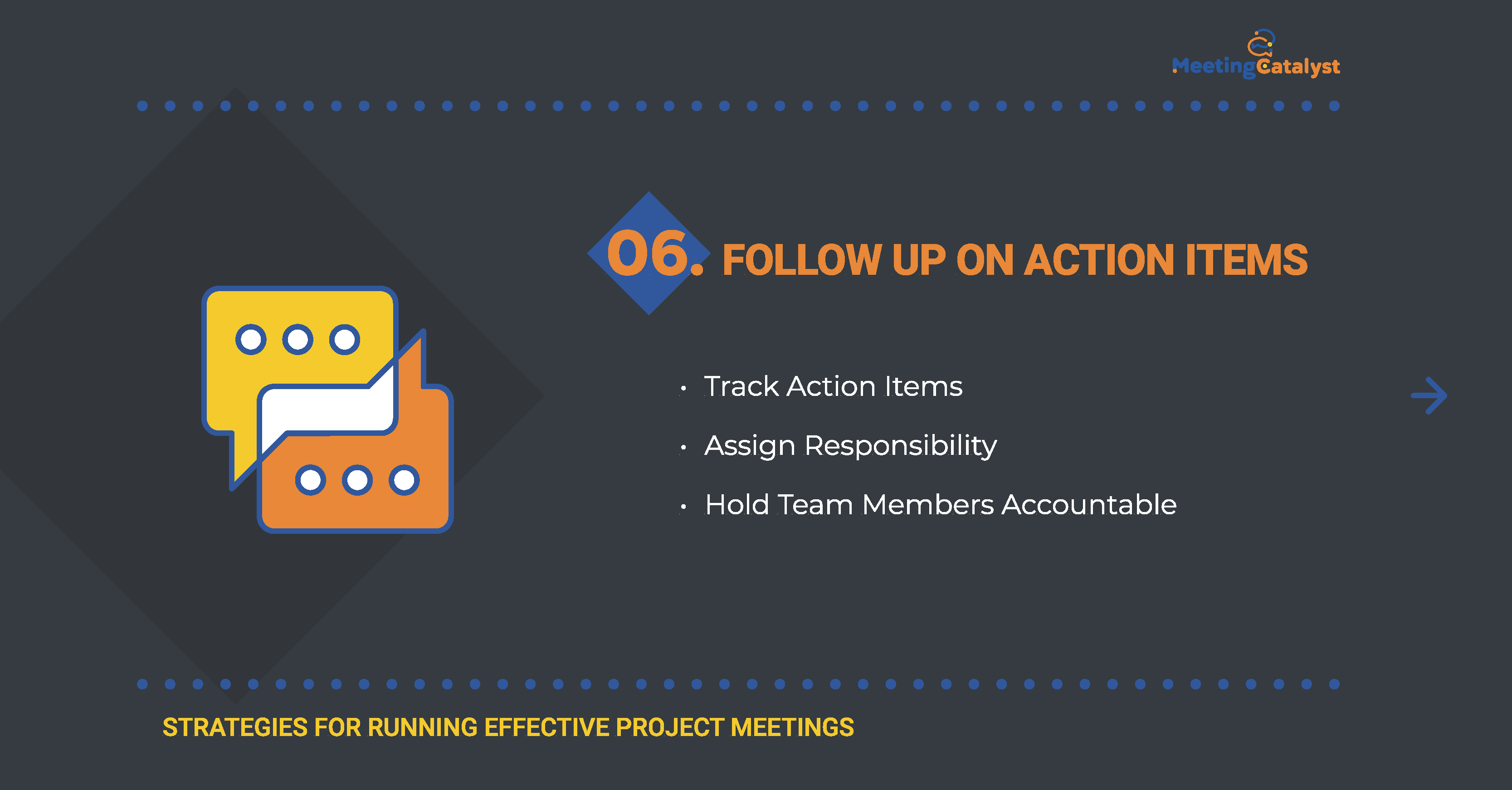
Following up on action items is essential for ensuring that tasks are completed and the project stays on track. Implementing a system for tracking action items, assigning responsibility, and holding team members accountable can help maintain progress and prevent tasks from slipping through the cracks.
Track Action Items
Create a system for tracking action items, such as using project management software, a shared document, or a dedicated task list. This helps ensure that all team members are aware of their responsibilities and deadlines.
Review and update the action items list regularly, both during and between meetings, to monitor progress and make necessary adjustments.
Assign Responsibility
Clearly assign responsibility for each action item to a specific team member, ensuring that they have the necessary resources and support to complete the task.
Encourage team members to communicate any issues or roadblocks they encounter while working on their assigned tasks so that they can be addressed promptly.
Hold Team Members Accountable
Establish a culture of accountability within the team by setting expectations and following up on the progress of action items.
Recognize and acknowledge the accomplishments of team members who complete their tasks on time and offer support to those who are struggling.
A project manager who successfully implemented these follow-up strategies saw a significant improvement in their team's ability to complete action items on time and keep the project on schedule. By tracking action items, assigning responsibility, and holding team members accountable, they ensured that tasks were completed efficiently and effectively, contributing to the overall success of the project.
Evaluate Meeting Effectiveness
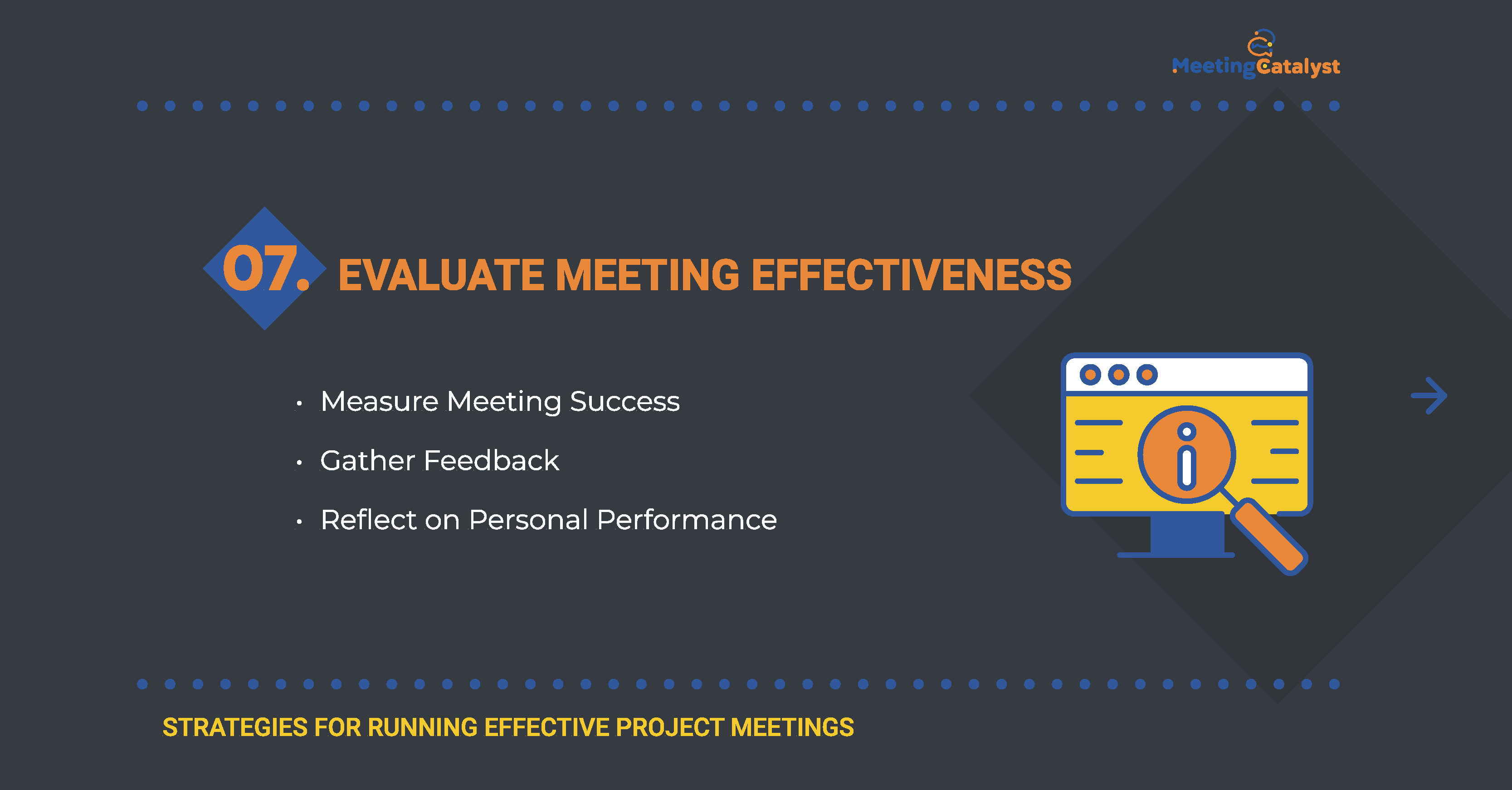
Evaluating meeting effectiveness is crucial for improving project outcomes and team performance. By measuring meeting success, gathering feedback, and reflecting on personal performance, project managers can continuously enhance their meeting management skills and contribute to overall project success.
Measure Meeting Success
Establish clear criteria for measuring meeting success, such as whether the meeting objectives were met, if all agenda items were covered, and if decisions were made or action items were assigned.
Monitor the progress of action items and other outcomes from meetings to assess whether the discussions and decisions made in meetings are having a positive impact on the project.
Gather Feedback
Encourage team members to provide feedback on the meetings, both in terms of content and structure. This can be done through anonymous surveys or open discussions.
Actively listen to the feedback provided and be open to making changes based on the input received. This will help create a culture of continuous improvement within the team.
Reflect on Personal Performance
Take time to reflect on your performance as a project manager and meeting facilitator, identifying areas of strength and opportunities for improvement.
Consider seeking guidance or mentorship from experienced project managers or attending professional development courses to enhance your meeting management skills.
One project manager who consistently evaluated meeting effectiveness saw significant improvements in their team's engagement and productivity. By measuring meeting success, gathering feedback, and reflecting on their performance, they were able to make informed decisions about meeting structure, content, and facilitation, leading to more effective and efficient project
Conclusion
Effective project meetings are vital for project success, as they foster communication, collaboration, and ensure that all team members are aligned with the project objectives. This article has outlined key strategies and best practices for running effective project meetings, including:
- Determining meeting frequency and duration
- Defining meeting goals and objectives
- Developing a meeting agenda
- Encouraging participation and collaboration
- Managing meeting dynamics
- Following up on action items
- Evaluating meeting effectiveness
By implementing these strategies, project managers can create a more focused, engaged, and productive environment for their teams. In turn, this will lead to better project outcomes and overall success. As a project manager or team leader, take the initiative to start incorporating these strategies into your project management practices today, and watch your team's performance improve and your projects thrive.